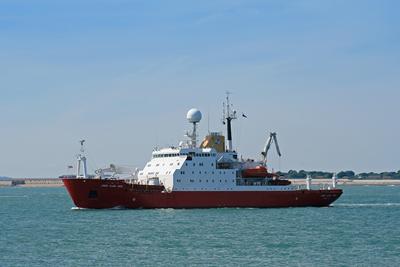Southampton scientists depart for arctic research expedition
This Saturday (7th July) a team of scientists, engineers, technicians and graduate students from the National Oceanography Centre Southampton will sail away from Reykjavik in Iceland for an eighteen day expedition to the seas around the Svalbard archipelago in the Arctic Ocean. Their objective will be to study plumes of methane gas leaking from the sea floor near the islands, and to investigate the geological processes beneath the sea floor that are causing this phenomenon.
The temperature of sea water just above the sea bed around Svalbard has increased dramatically (more than 1 degree C) in the last thirty years; and a number of geological and geophysical studies have revealed large amounts of methane locked up within the sea floor sediments in the form of ‘methane hydrate' - a solid material made from water and methane, which forms at low temperatures and high pressures. The suspicion is that global warming, which is at its most extreme at high latitudes, is destabilising these huge deposits of methane hydrate beneath the sea bed, leading to the release of plumes of methane gas into the seawater above. Methane in the atmosphere behaves as a ‘greenhouse gas' in the same way as carbon dioxide - except that methane is many times more powerful as a ‘greenhouse' agent than carbon dioxide. Climate scientists have warned that global warming leading to release of methane from geological reservoirs, for example by destabilisation and dissociation of submarine hydrate deposits, could create a strong ‘positive feedback loop' for global warming - warming releases methane which causes more warming which releases yet more methane. Scientists studying climate change in the geological past have found some evidence that this process has taken place previously, during periods of rapid warming of the climate.
The geophysical, geological and geochemical research to be carried out during July's expedition will be focused on efforts to quantify just how much methane is present in hydrate and gas form beneath the sea bed in the affected areas, and to investigate whether the bubble plumes seen at the sea bed are indeed related to increasing temperatures, or whether other natural causes may be at work.
The research will be led by Principal Scientist Professor Martin Sinha of the University of Southampton. The research team is drawn from the Universities of Southampton, Durham, Bergen (Norway) and Barcelona (Spain), and from the Natural Environment Research Council's National Oceanography Centre and National Marine Facilities groups - which share the purpose built Waterfront Campus site in Southampton with the University of Southampton's Ocean and Earth Science. The research will be carried out from the Royal Research Ship James Clark Ross, an ice breaker which is equipped with a sophisticated array of sensors and research laboratories and which is operated by the British Antarctic Survey. The scientists will use sonar, acoustic and seismic surveying instruments; autonomous lander instruments which will be deployed on the seabed to make electromagnetic measurements; chemical sensing devices; and two separate underwater research vehicles, ‘DASI' and ‘HYBIS', both of which operate just above the sea floor, connected to the ship by up to 4 km of umbilical cable. The research is just part of a larger, international research effort which will see two other expeditions visiting the same area this summer.
Later this year, the James Clark Ross will return to the Antarctic - travelling the full length of the Atlantic Ocean to maintain her annual mission of supporting science in the Antarctic during the Austral summer, while returning to the northern hemisphere for refitting and for carrying out more polar research in high northern latitudes during our summer months.

What's related
Links to external websites
The University cannot accept responsibility for external websites.